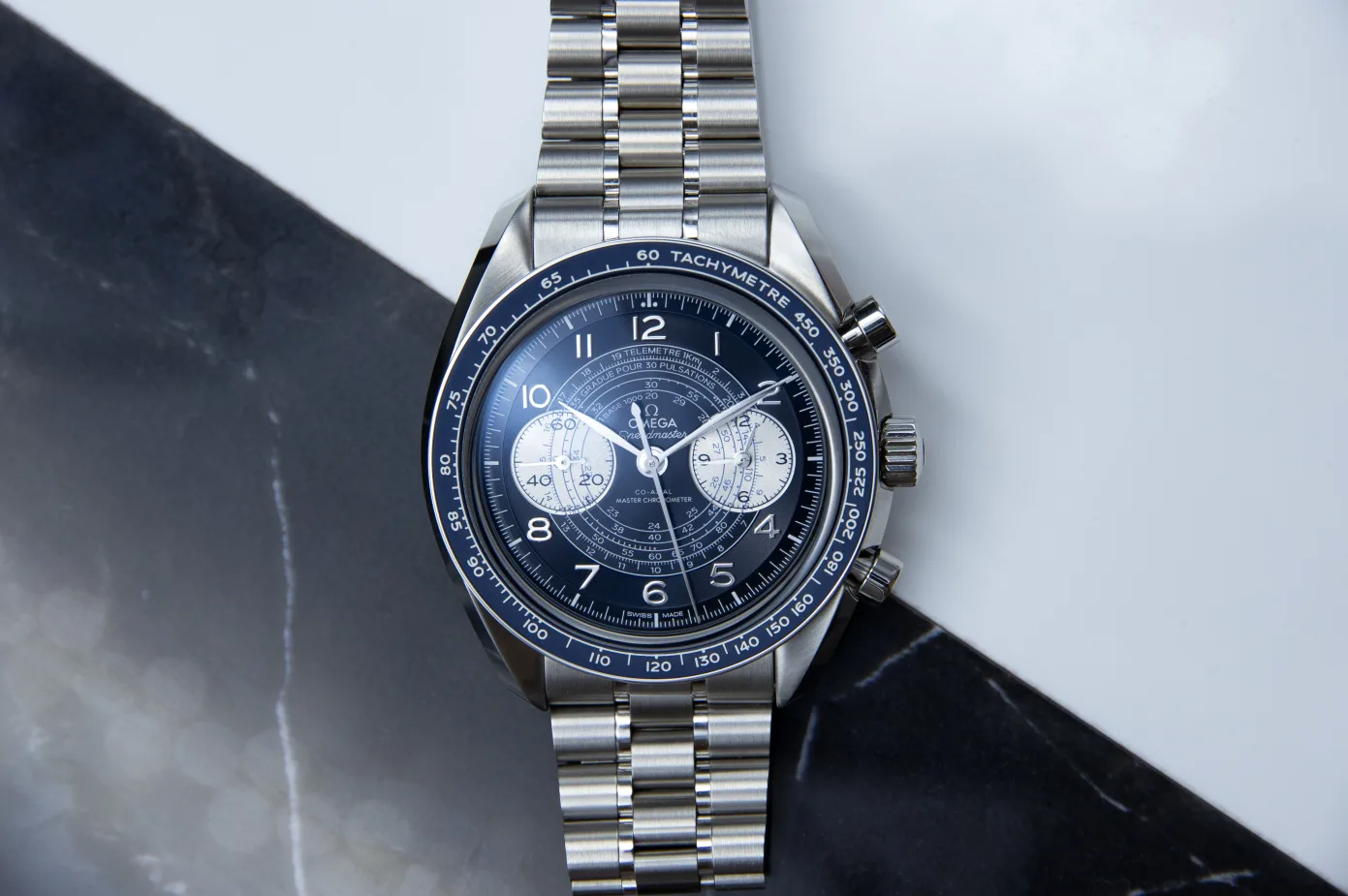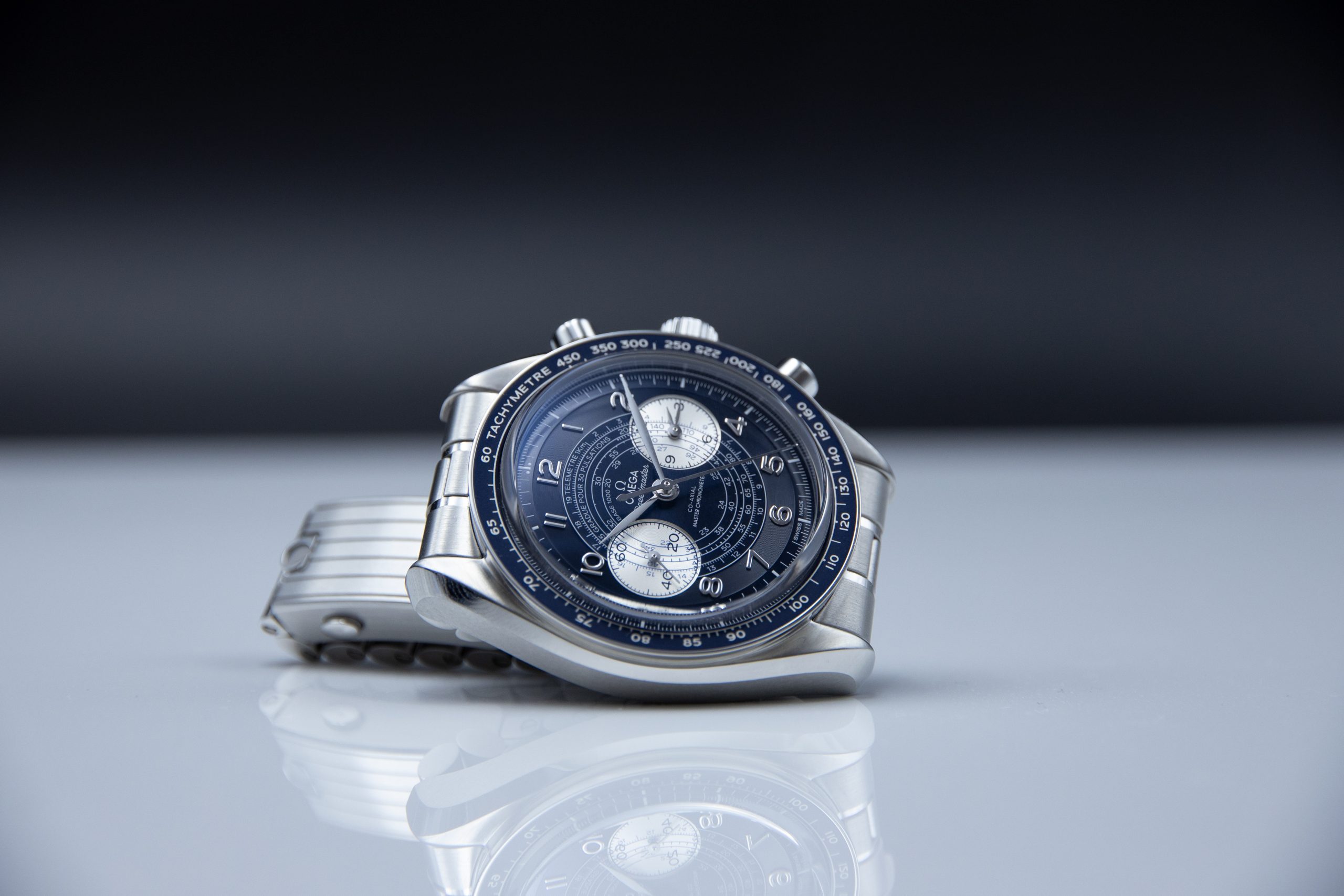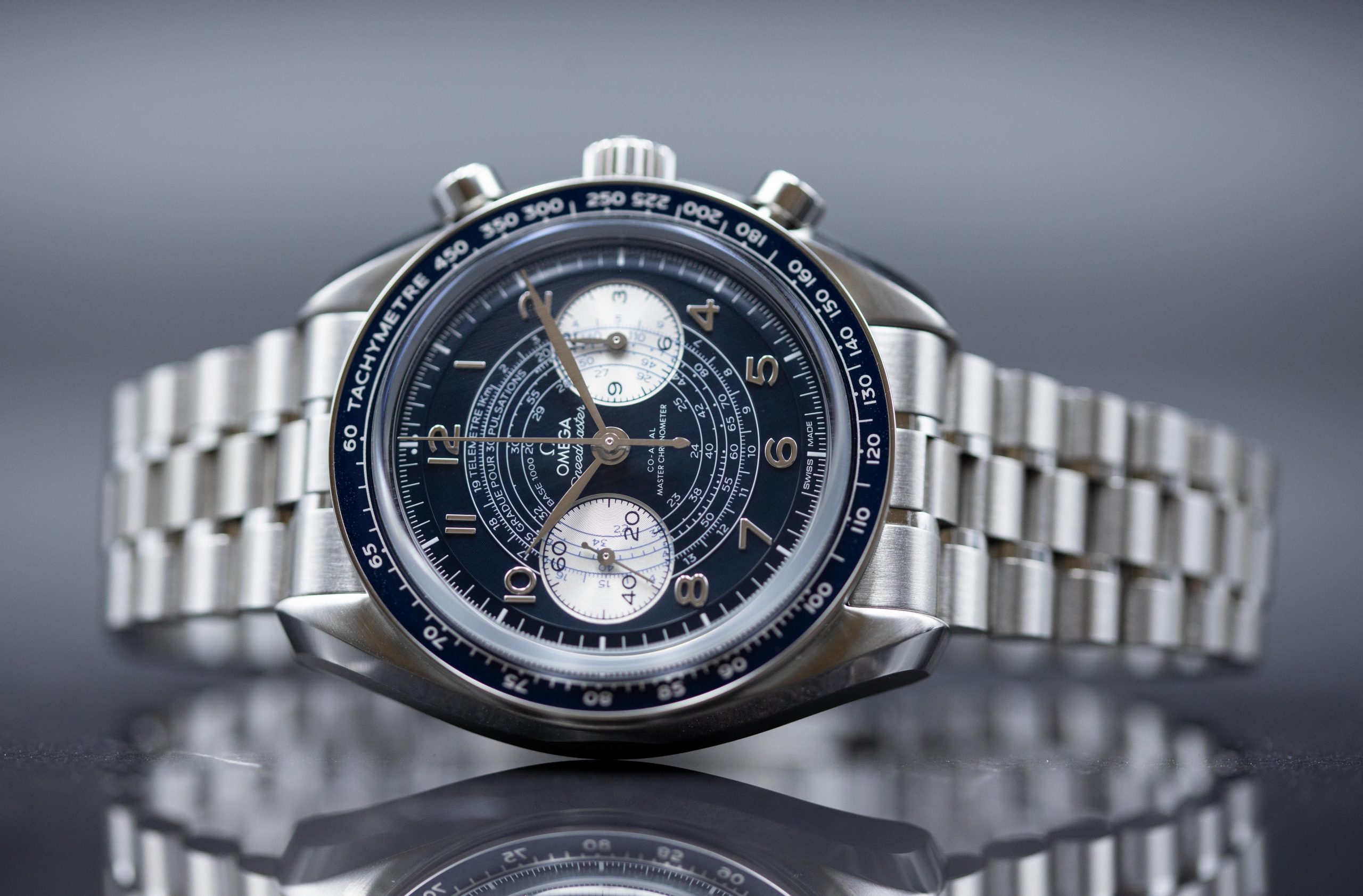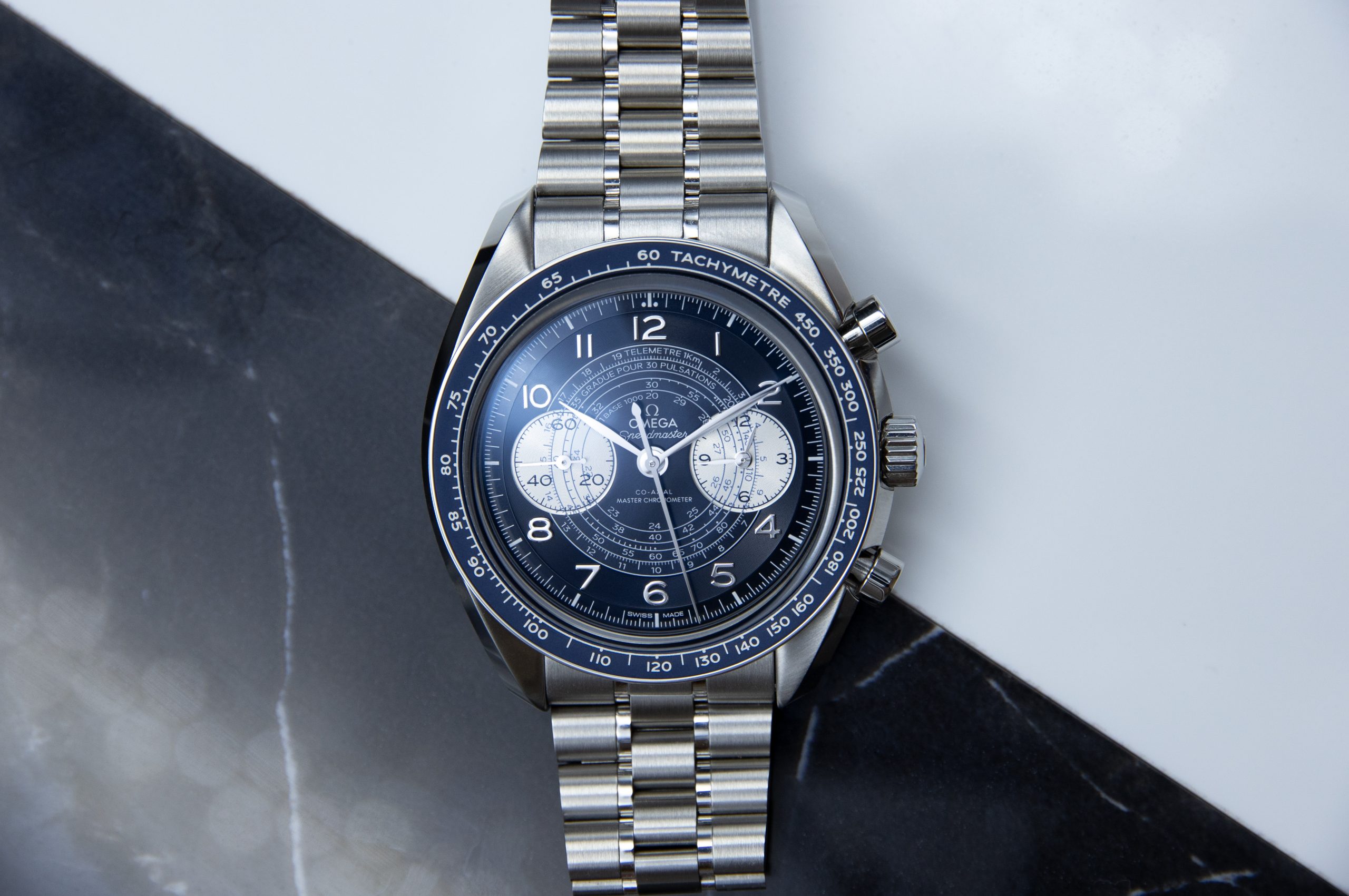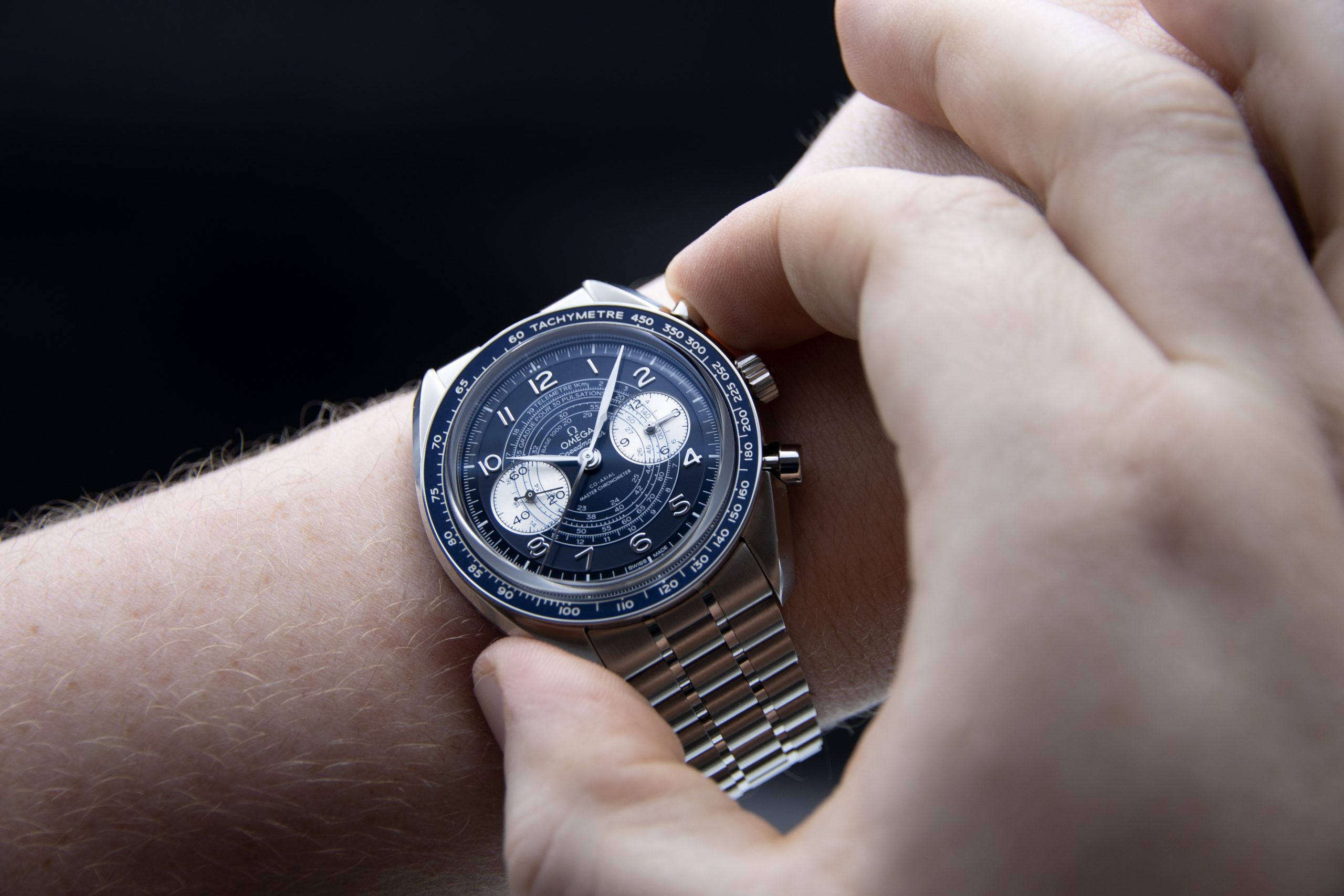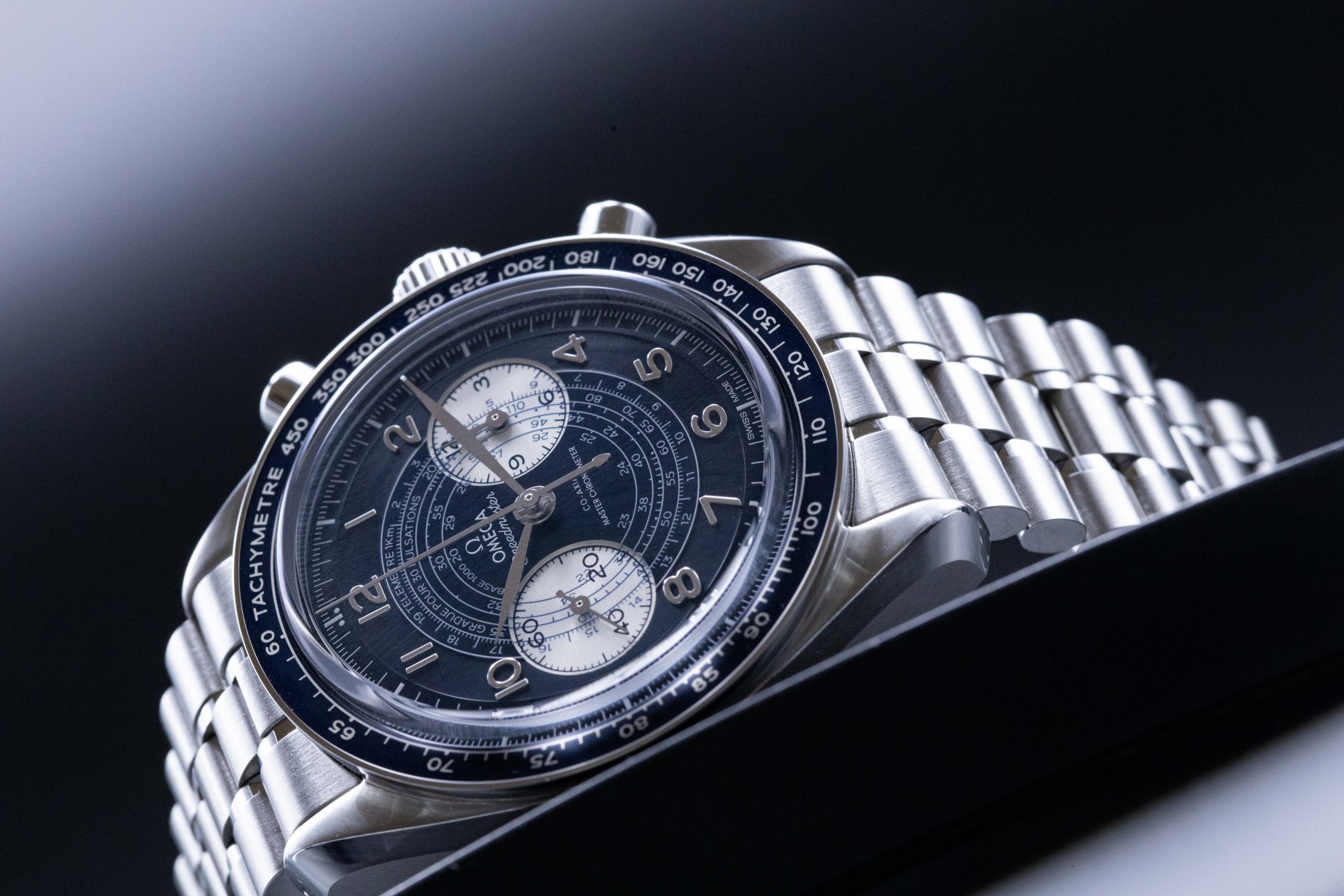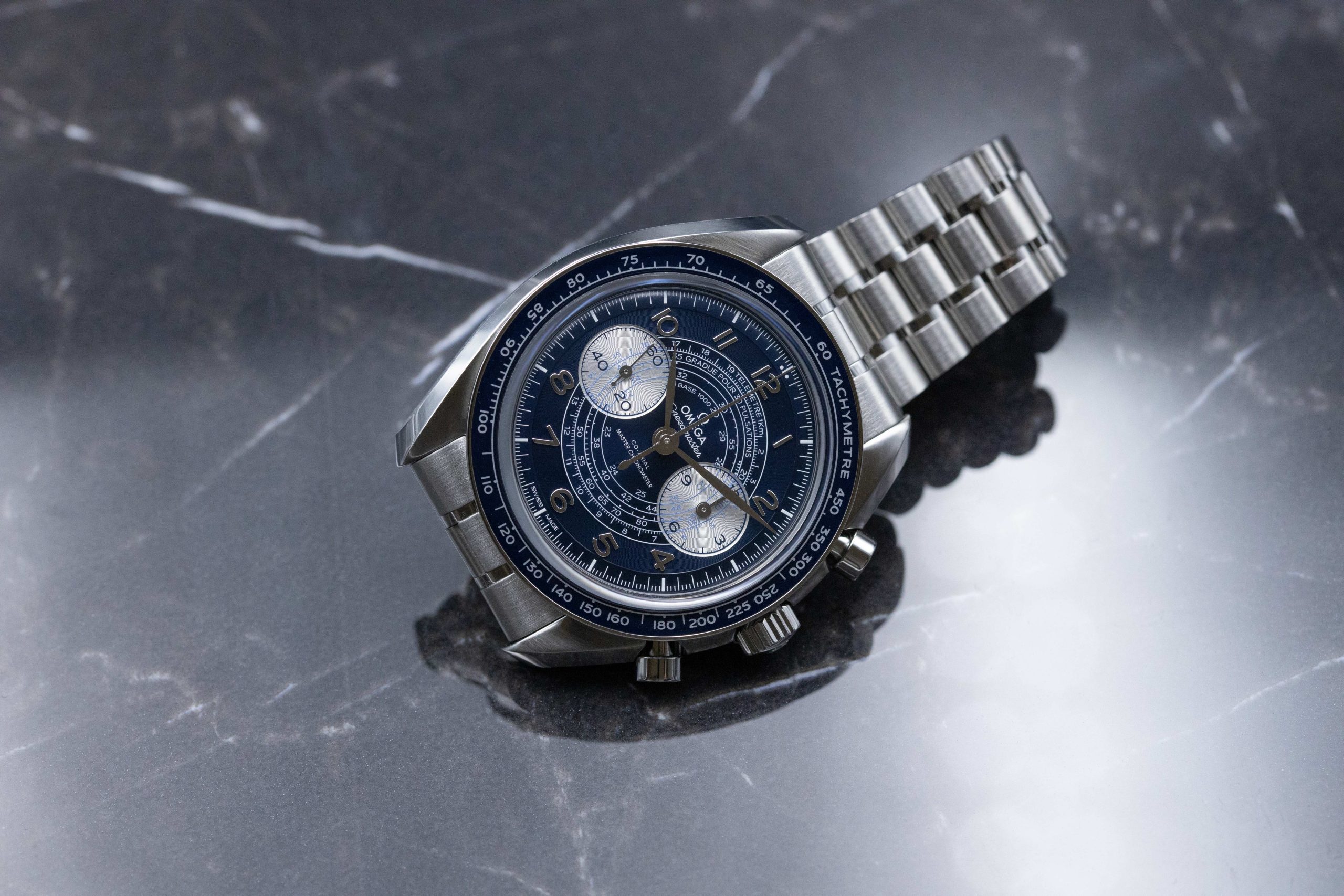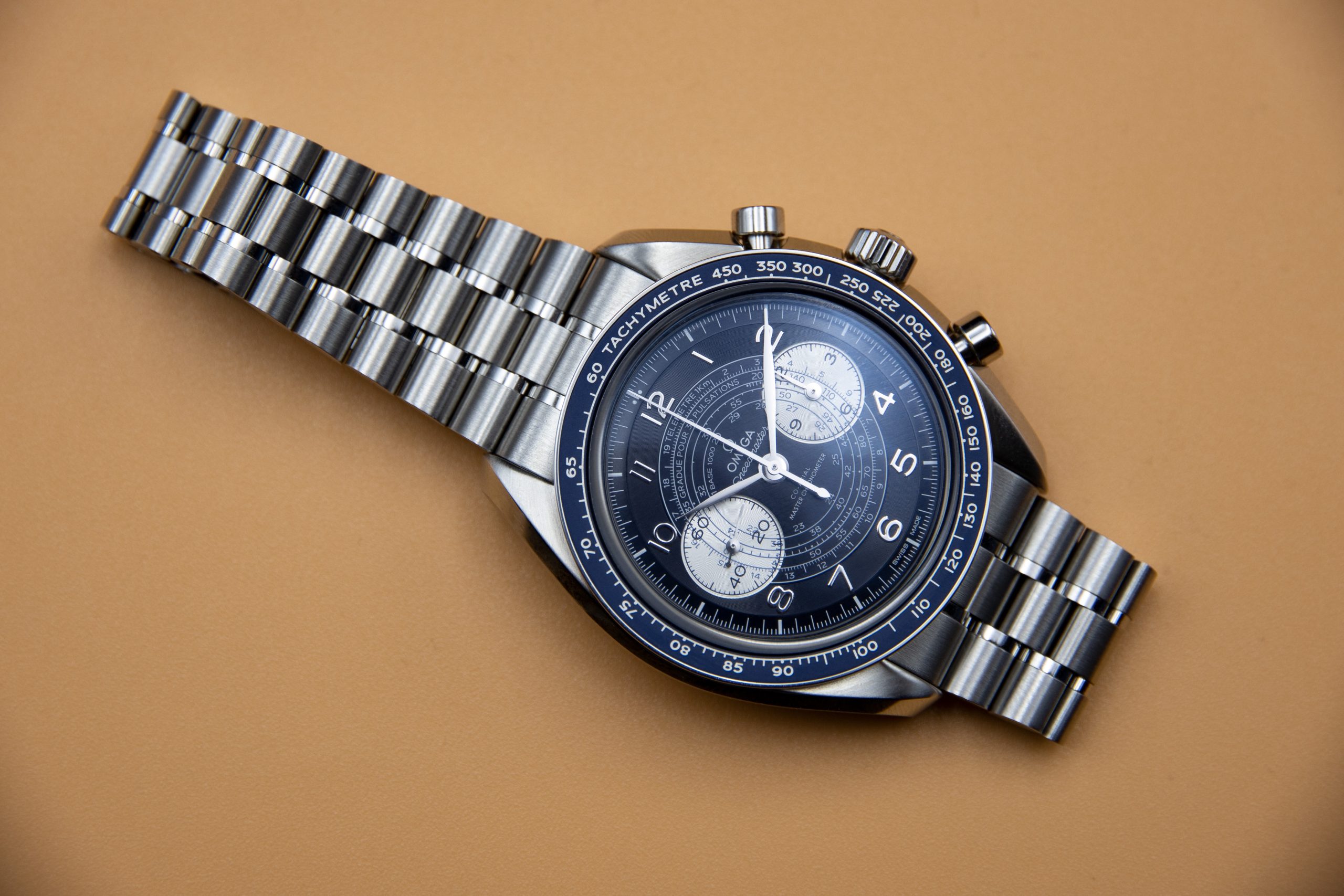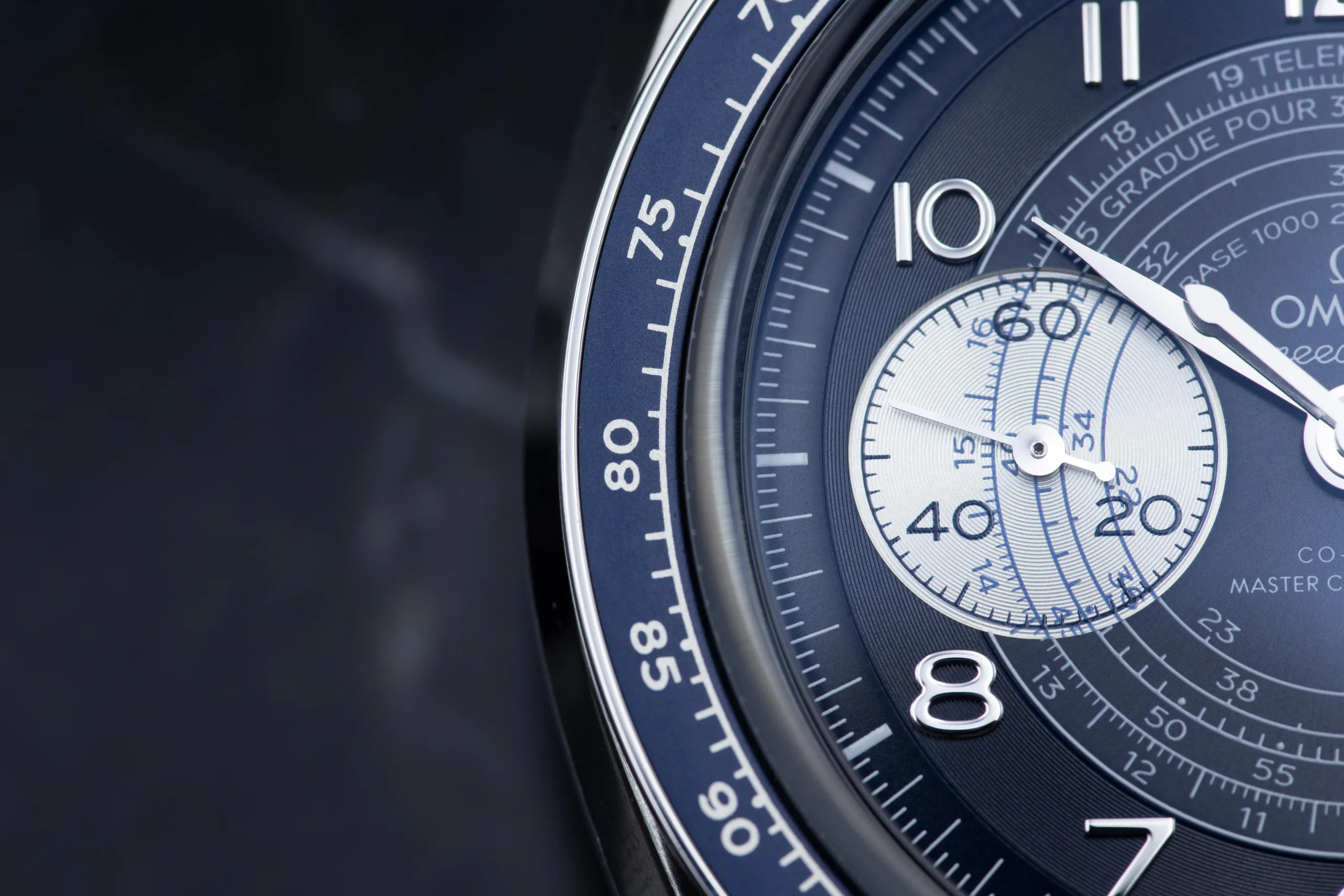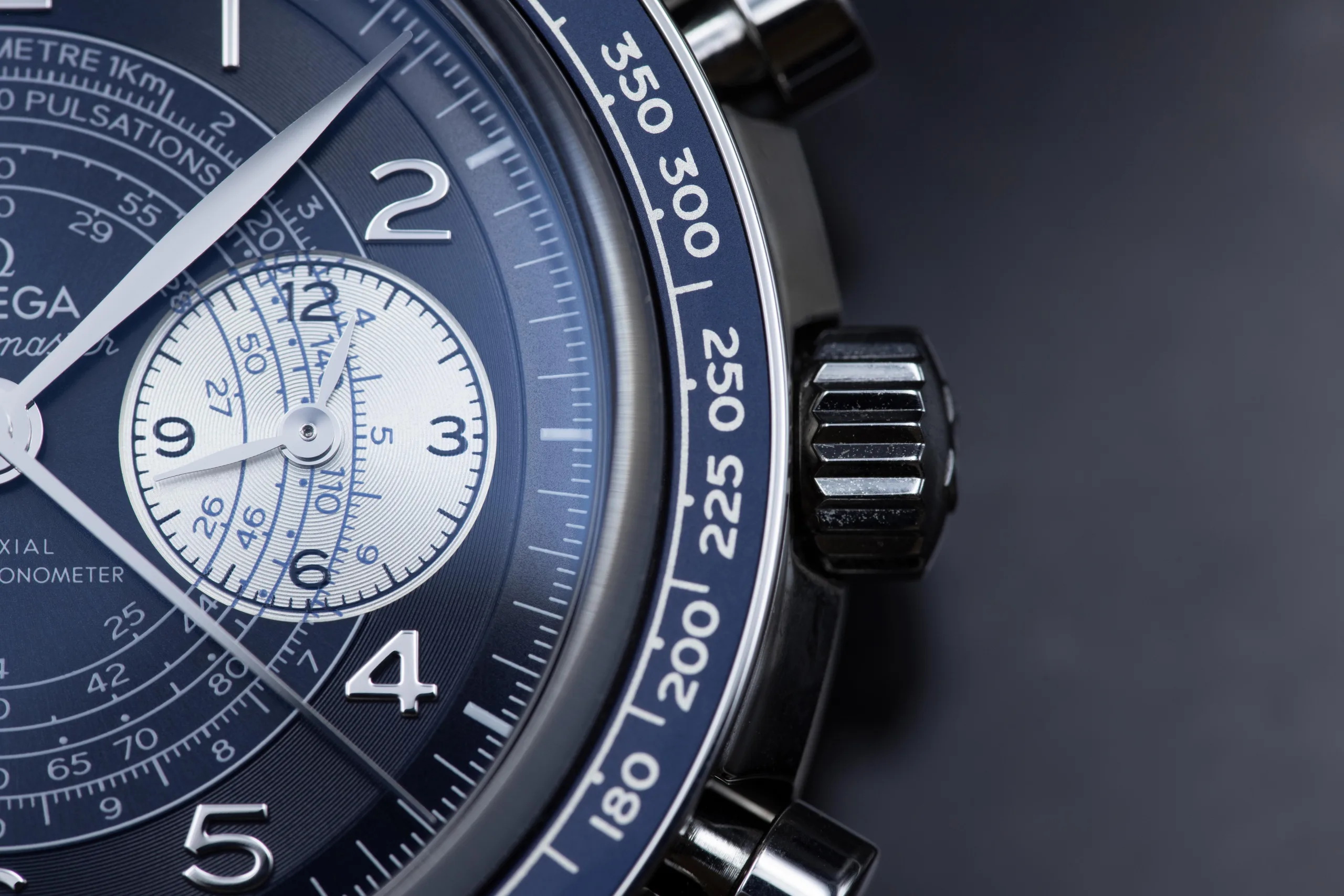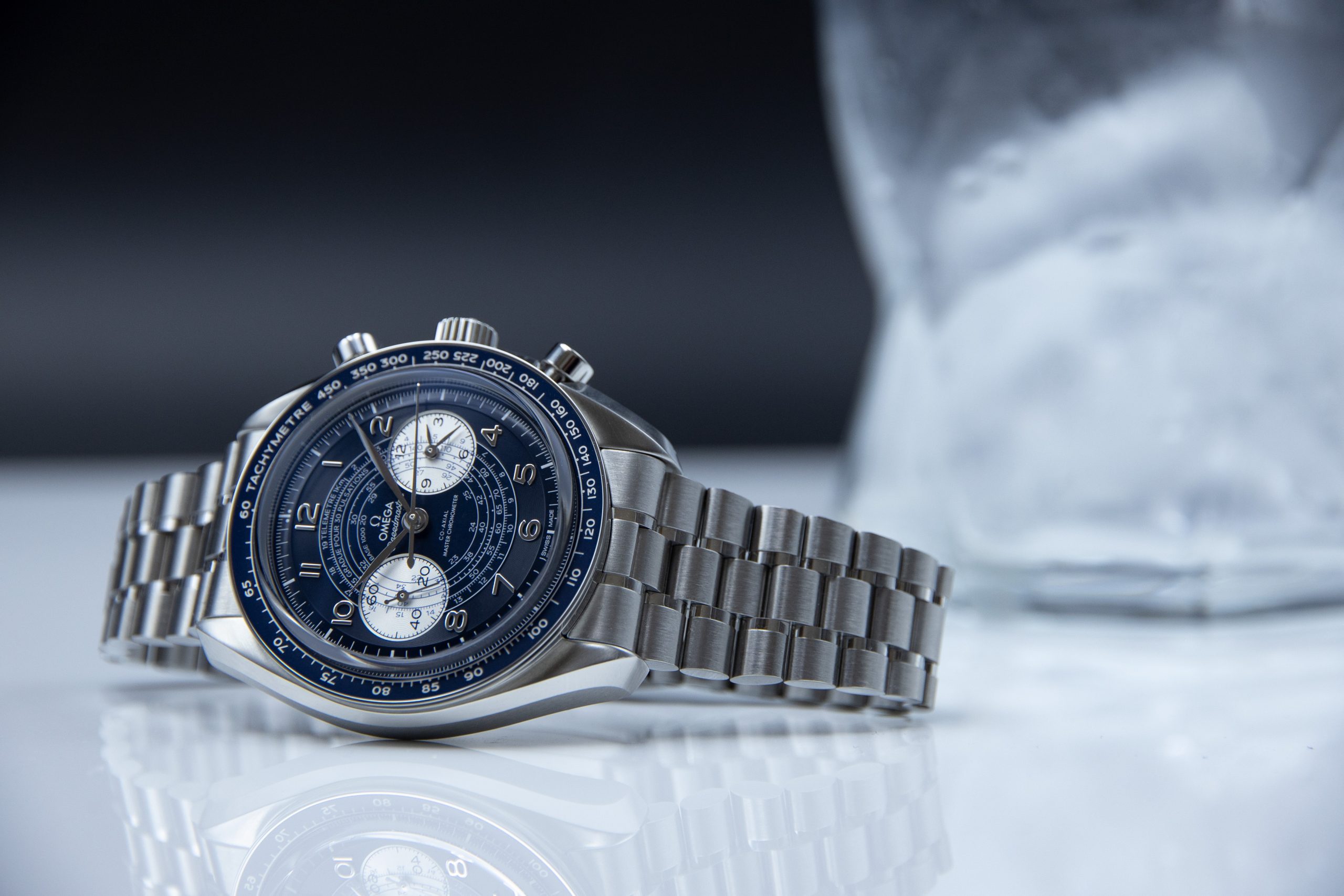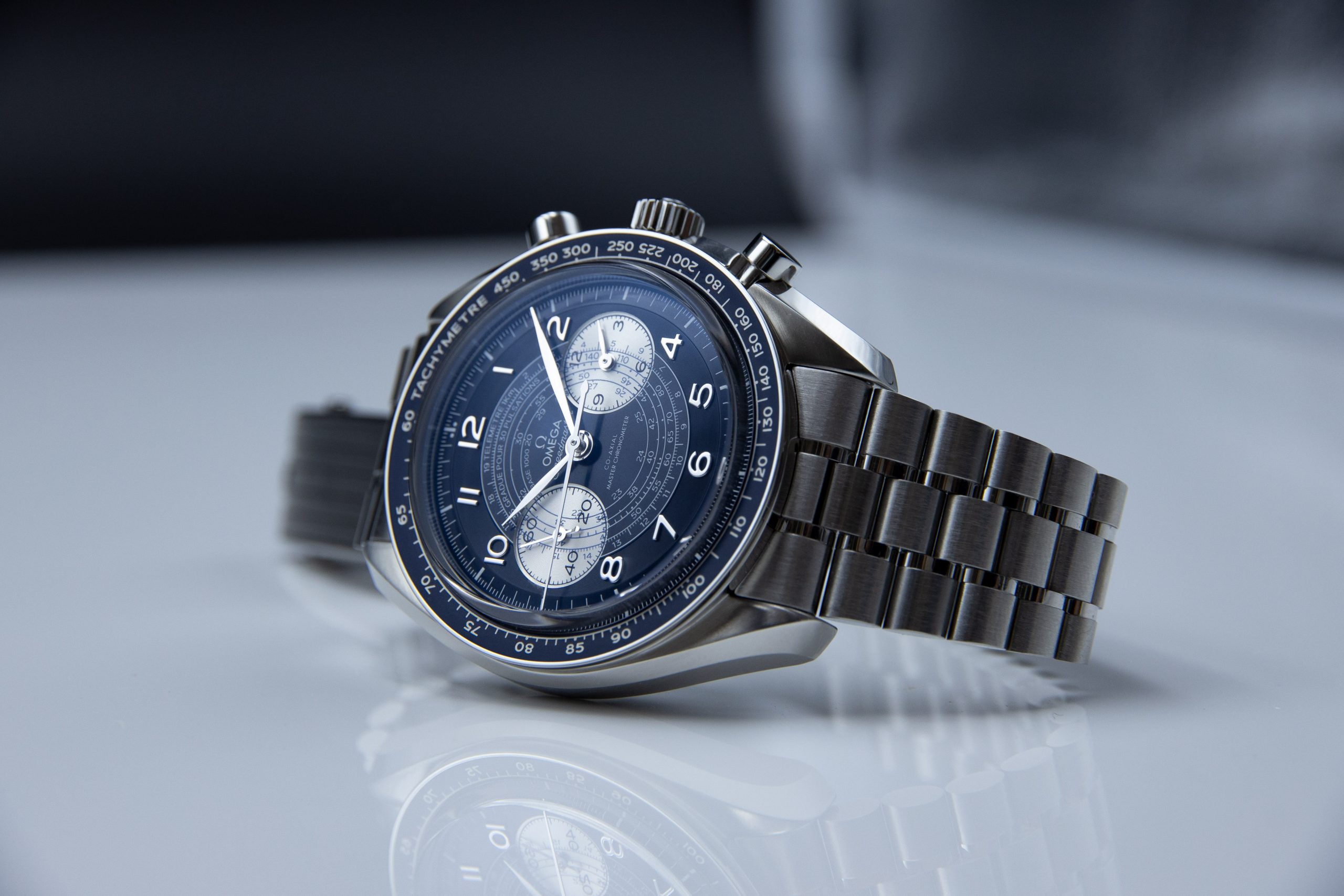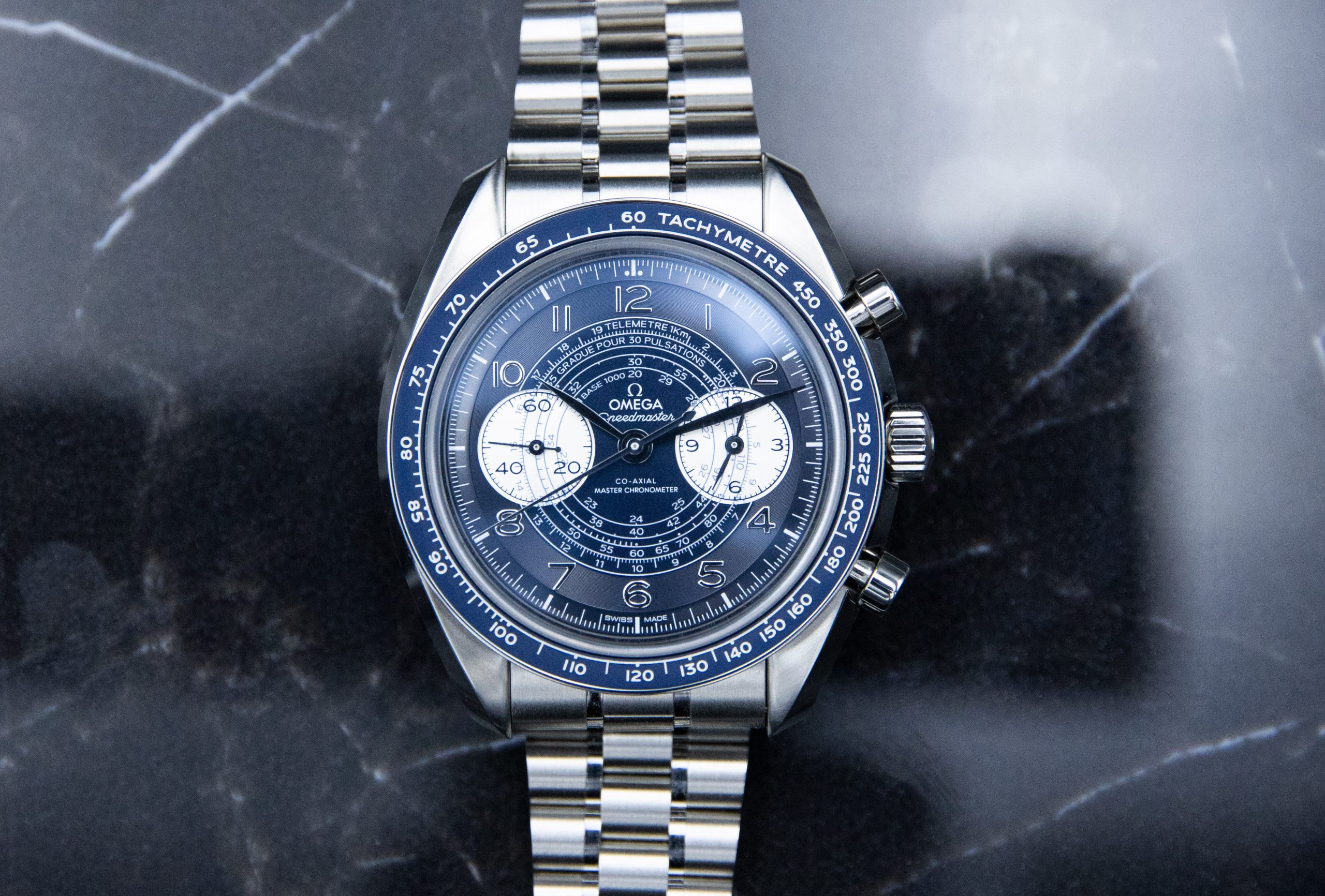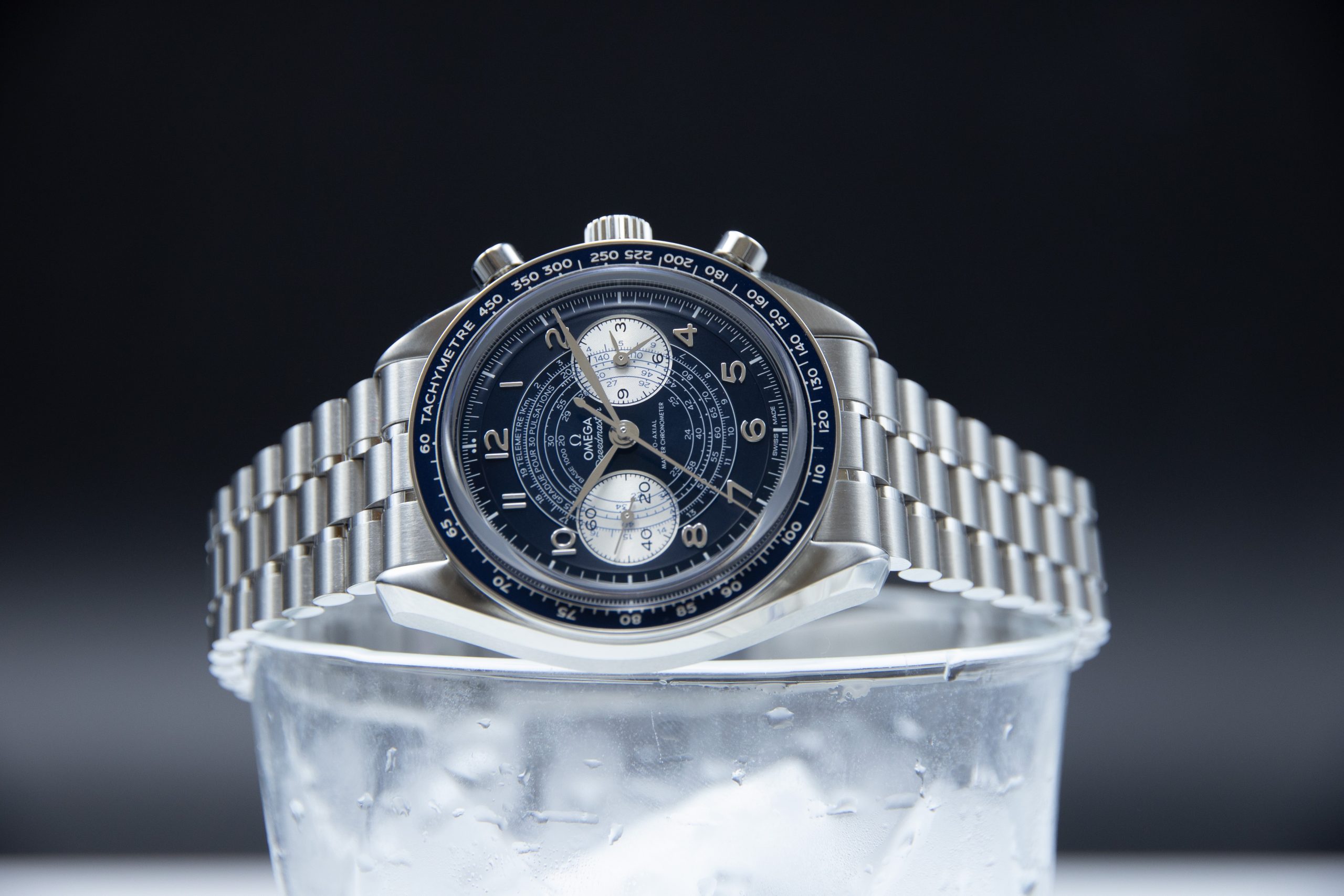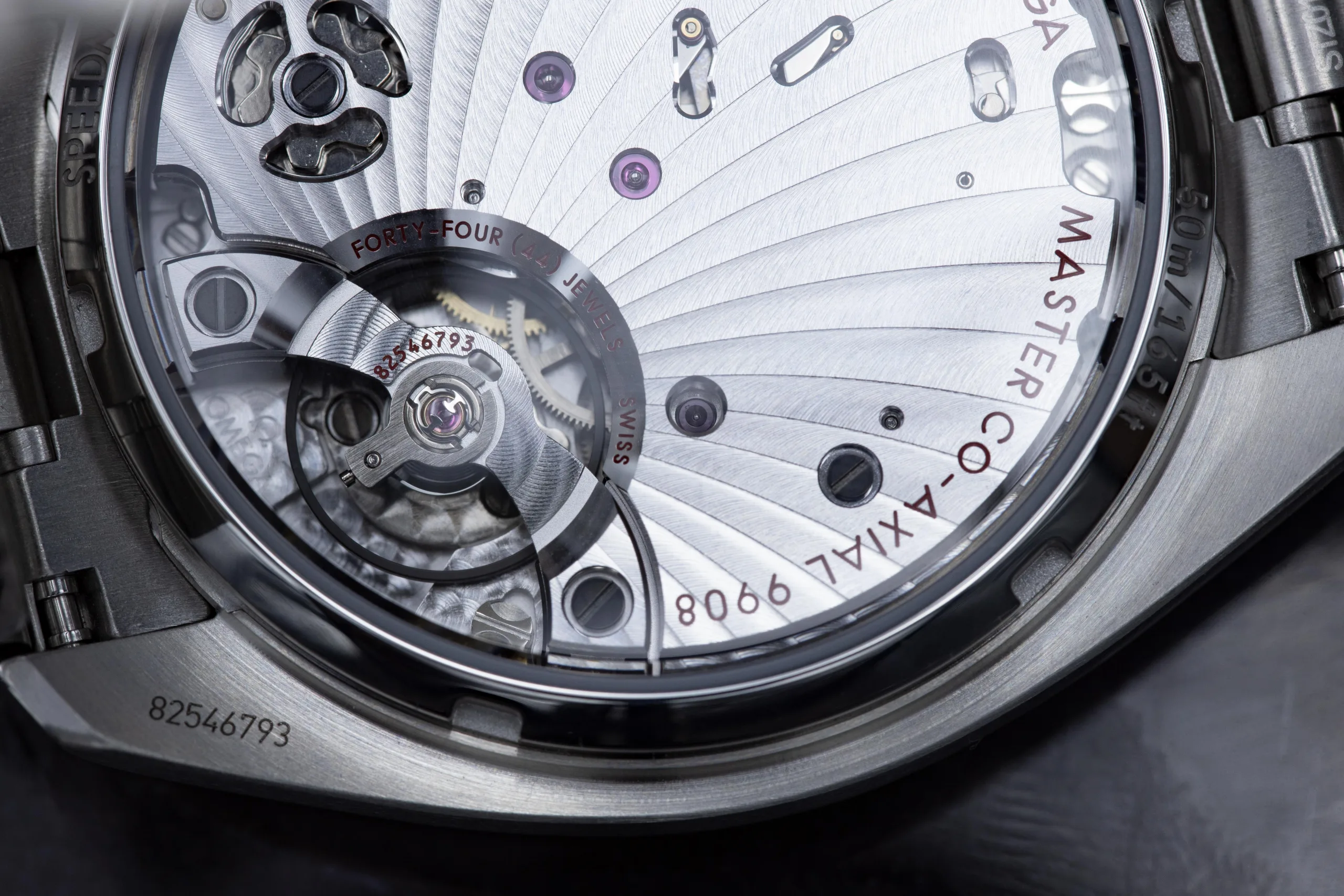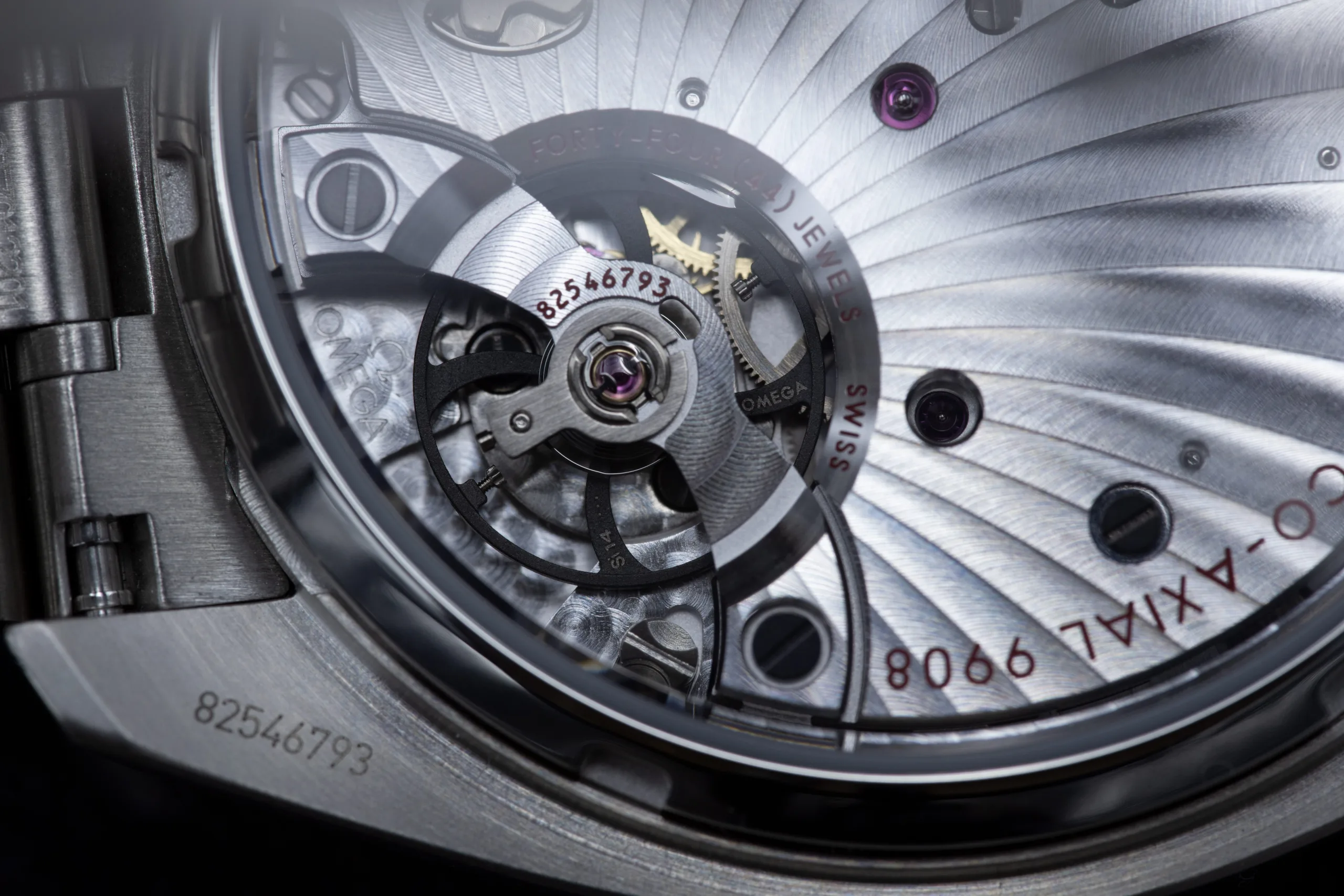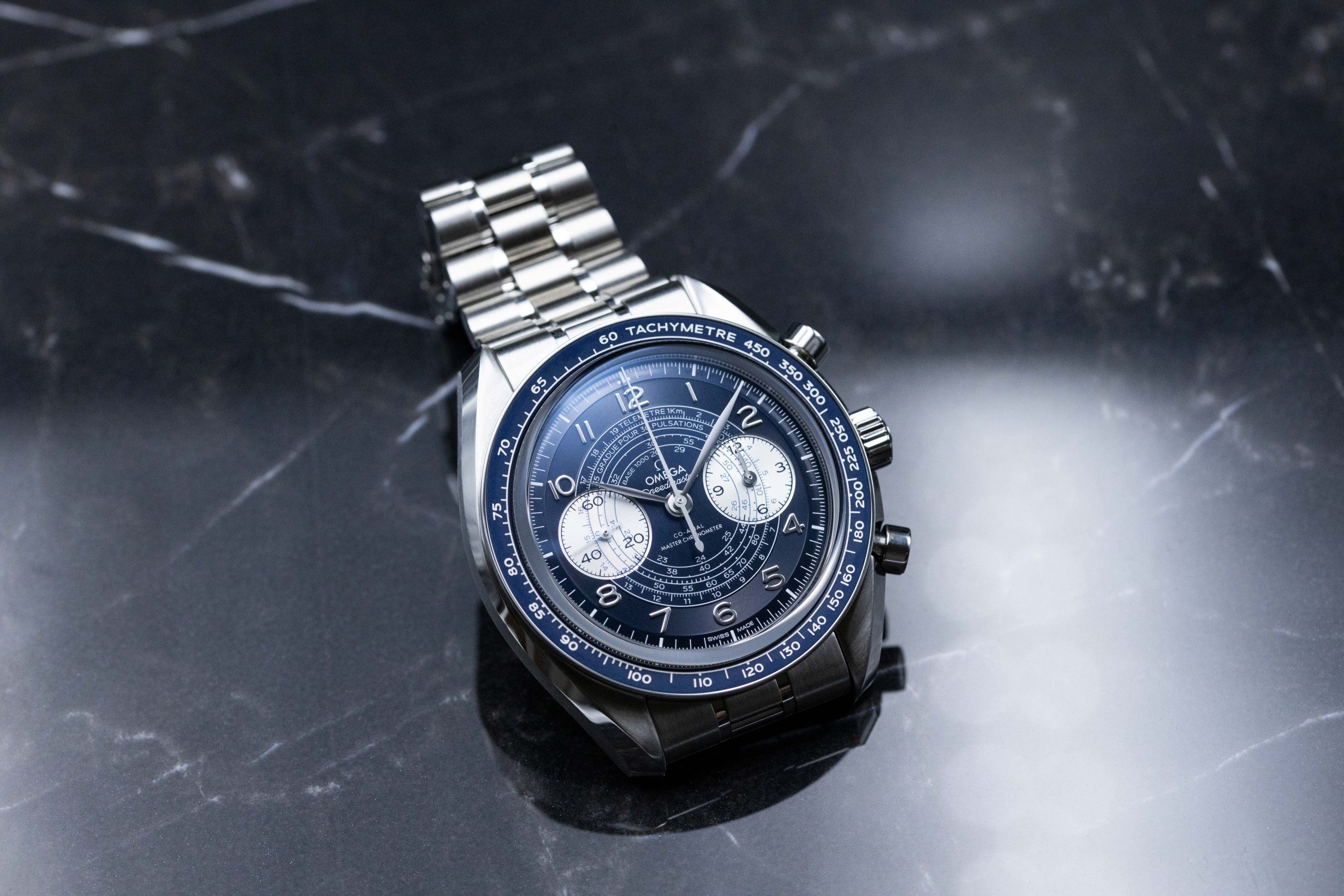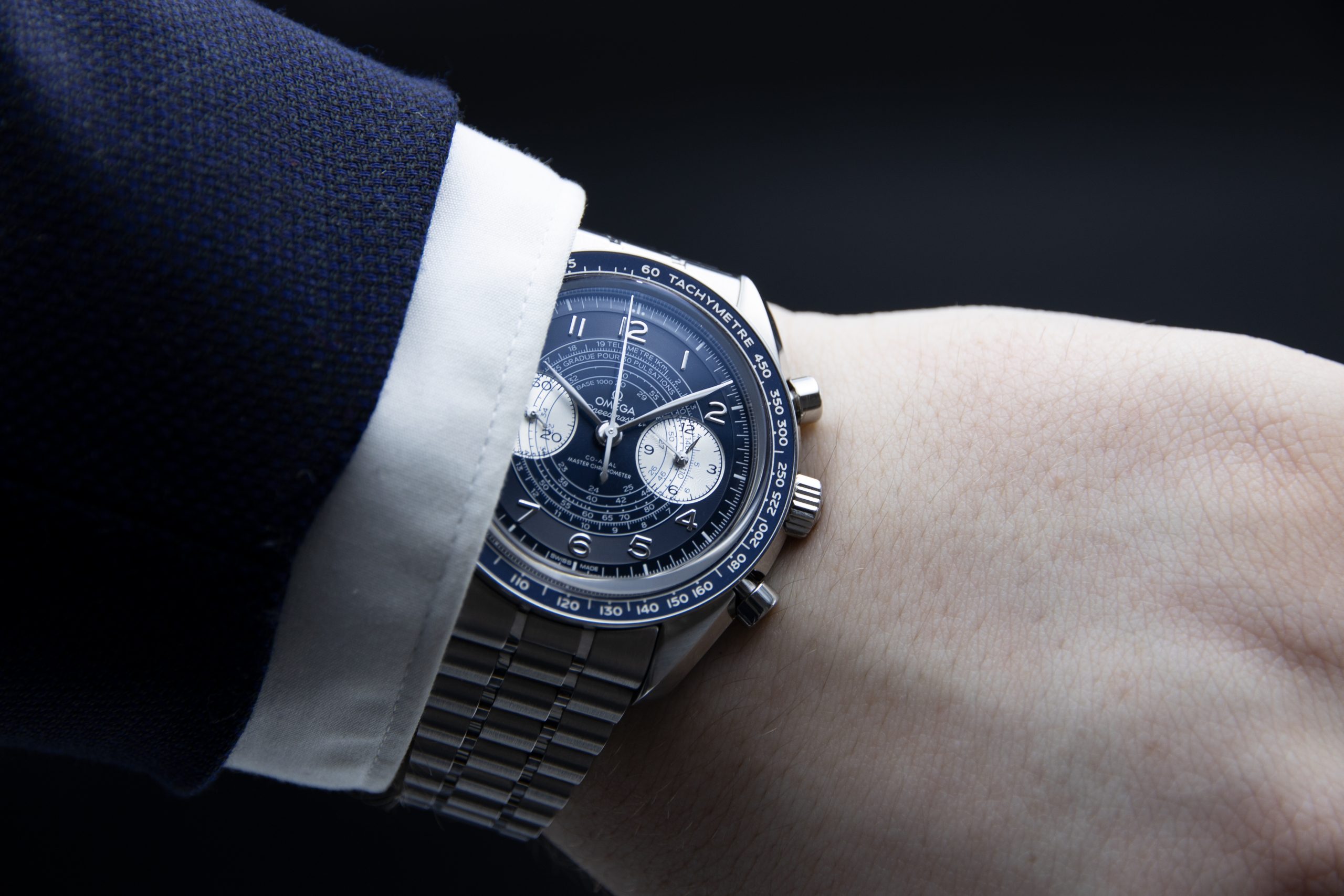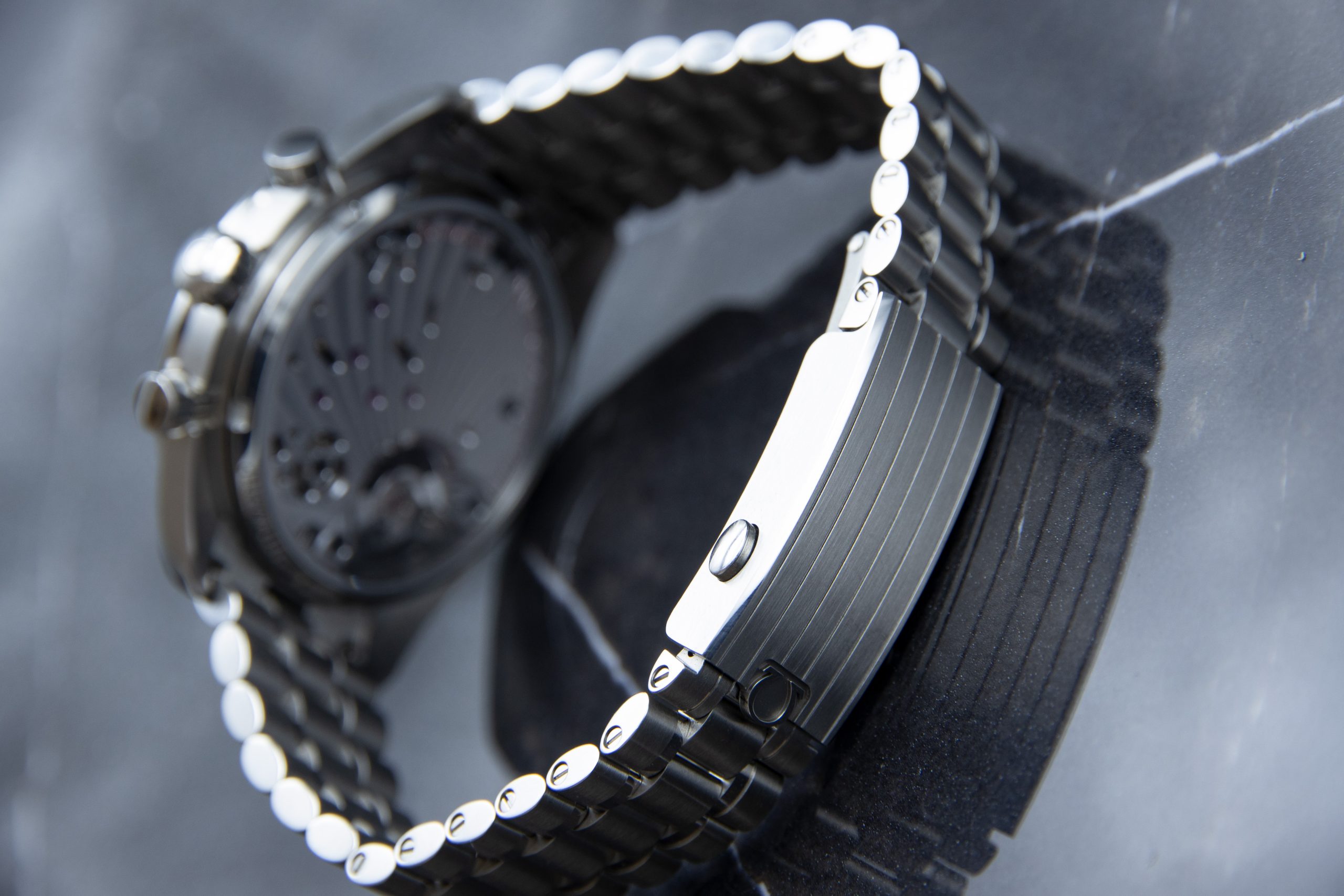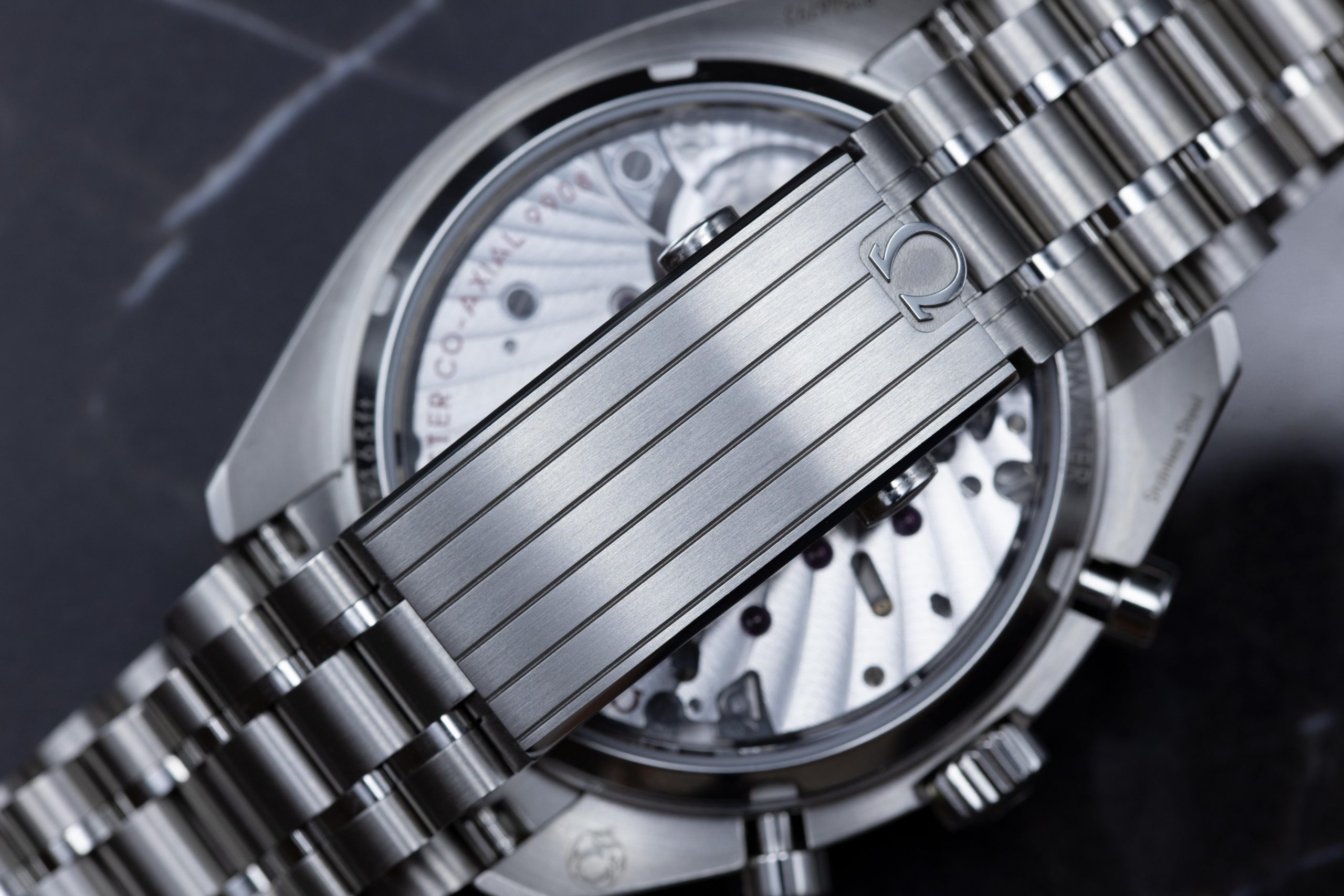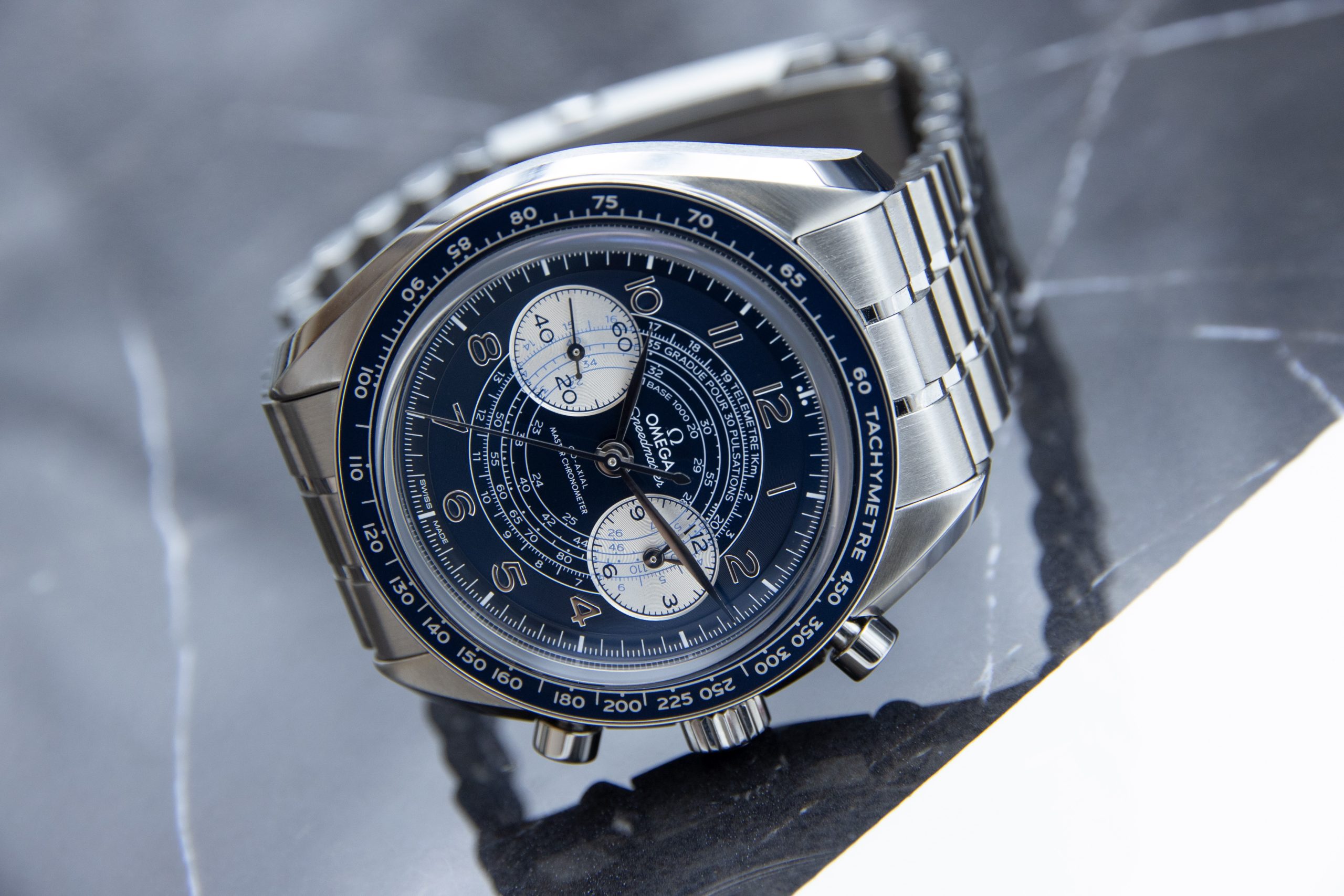BY HARLAN CHAPMAN-GREEN
The Speedmaster is one of Omega’s most popular watches because it caters to all people in one way or another. The classic Speedmaster Moonwatch is the obvious (but great) choice. There are also Speedmasters for women, Speedmasters for people who want more horological engineering thrown in as well (in the form of the Apollo 8) and Speedmasters which perform way more than the original did (I’m talking about the moonphase with the calendar here). It seems then that in this age of Speedmasters becoming more complicated, something needed to come along to balance it out, and I just happen to have had a hands-on with it.
It’s called the Speedmaster Chronoscope and, granted, is not a brand new watch. It first appeared in September of 2021, but with life being the way it is, I was in the middle of a Master’s degree when that came out, so no time could be spared for watches. Happily, that has now passed, and I have been able to get my hands on a Speedmaster Chronoscope, so here’s what I think of it.
Firstly, let’s start with appearance. It’s a great-looking piece in person. I had the blue dial with white markings and subdials and a steel bracelet. This combination was particularly appealing because I prefer darker dials, but if you like white dials, then Omega makes Speedmaster Chronoscopes with those.
The combination of brushing and fine polishing makes this watch stand out. It’s something that Omega has been doing for years now and to great effect. The majority of the watch has been brushed, but the diagonal sections of the lugs, some of the bracelet’s centre links, the pushers, and the bezel assembly are all polished and shine very well indeed. It adds a layer of sophistication to the Speedmaster. Mechanical watches surpassed the need to be tools long ago, so it’s only fair that watchmakers make these more luxurious to compensate.
From a distance, it looks more like a classy dress watch. In a sense, that’s what this is. It’s got a movement ready for the bumps of daily life, but I wouldn’t expect this to perform as a Seamaster does. Luckily, Omega also makes the Seamaster, so if you do need something that’s strong like a brick you-know-what house, then you’re covered. This watch is limited to just 50m of water resistance, enough not to trouble it if you splash it when washing your hands, but not something you’d want to swim or dive into a pool with unless you like worrying constantly. The holes for the pushers are extra places water could ingress, and the lack of a screw-down crown firmly puts this as a dressy-but-capable watch rather than an extremely-capable-but-wearable one. The blue of this watch’s dial and bezel also affirms this dressiness, in case I haven’t affirmed it enough for you.
Even the watch’s sizing seems modest. Omega says it’s a 43mm watch, although it seemed to wear smaller on the wrist. Presumably, a thinner movement lacking an automatic rotor helped with this. If you’ve tried out the 44mm Speedmaster calendar I mentioned earlier, you’ll know how chunky it is. This one wasn’t chunky. It fitted my wrist well and looked the part. Oh, if you’re interested, I measured the mass of the watch on my VSS (Very Scientific (Kitchen) Scales), and it came in at 145 grams. I really need to make a spreadsheet of all the results sometime.
As I mentioned, the case dimensions and the colours involved evoke a smarter level of dress sense with this Speedmaster, so let’s now look at the dial, which is where the most influence from the dress watch world has taken effect. As you can see, a lot is going on, but if you’re only telling the current time at a glance, you’ll be pleased to know that it’s very legible. You need to see this in person, or at least see it in live pictures like mine. Press renderings do no justice to this. They never will.
Despite the amount of detail printed on it (which I’m coming onto soon), the depth effects of this watch mean it reads well. The polished feuille (leaf) style hands sit quite high above the dial, meaning your brain can detect the difference in distance between the hands and the dial, creating said depth effect (this doesn’t work if you’re a cyclops or if you only have one eye working, but even then it shouldn’t be too bad). I should also point out that, from my experience, this depth effect and the polishing means this watch is surprisingly legible at night. While a lack of any lume means it’s not useable in total darkness, I was wearing it while watching TV in the dark and it was easy to tell the position of the hands, so the lack of lume isn’t a deal-breaker (not that I thought it was, but I know some of our readers might). You’d probably be able to tell the time on it in a cinema or while outside as long as there is a small amount of light, so it’s not a detractor.
Now, onto the most obvious part of the watch’s design. The chronograph layout is inspired by watches from the 1930s, which had to perform a number of functions. Luckily, a chronograph can be used to do this. Unfortunately, as with most watch dials like this, it is fairly illegible at a glance if you’re trying to tell anything other than seconds. There’s no way around this. It’s not possible to put all that info on a dial, have it readable and look good while in a 43mm case. However, I think an argument could be made for it, and it’s a pretty simple one. If you’re using the chronograph to time something, the chances are you’ll be looking at the dial for longer than a fleeting second. If you only need a second, then the long seconds hand is polished and readable like the minute and hour hands. However, my point is that this dial is legible so long as you spend a few seconds looking at it. Even the polished silver hands on the silver subdials are fairly readable.
In terms of functions, there are a few. The bezel is reasonably obvious, it’s a tachymeter, which we’re used to seeing. You can use it in one of two ways: to measure the speed of something travelling over a known distance or the distance something has travelled at a given speed. It doesn’t matter which distance unit you’re using, either. That distance could be millimetres, miles, fathoms or more. Interestingly, this watch combines the bezel with the dial. The innermost rings of the scale (the ones which are marked base 1000) pick up from where the bezel finishes at 60 and allow you to time down to 20 units if you so wish.
The outermost ring on the dial is the telemeter. A telemeter is used to determine the distance between you and an event. Let’s take a lightning strike. A thunderstorm is raging outside, and for curiosity’s sake, you want to know how far away it is. Traditionally, you’d wait for a lightning strike and then start counting numbers and saying the word Mississippi in between, but I know I always get caught up and forget where I got to. By using a telemeter, it’s possible to find this distance more accurately. By starting the chronograph upon seeing the lightning and stopping it upon hearing the thunder, you can see where the seconds hand got to. This indicates your distance from the lightning strike. In this case, the telemeter measures in kilometres.
Heading inwards, we can see a mysterious ring that says Gradue pour 30 pulsations. This is a pulsometer scale and is the most specialised of them all. Common on watches from the early to mid 20th century, the pulsation scale measures heart rate in beats per minute. Firstly, you need to find a pulse (sorry zombies, this one’s not for you). When ready, you start the chronograph. The bit in French about 30 pulsations is the scale you need to use. The watch tells you to count 30 beats and then stop the chronograph. The position of the seconds hand is your beat rate, and the watch is already calibrated, so you don’t need to do any mathematics to figure out a beat per minute rate.
I like that Omega didn’t go over the top with finishing the rest of the dial knowing that these scales are here. The applied Arabic numerals sit on a guilloché track, causing little fuss and staying out of the way. Thankfully, there’s no date window here either; I feel that would have been a step too far. Sure, some might say something along the lines of “in for a penny, in for a pound”, and I get that, but it doesn’t need it in this case.
So what’s powering all this apparent legibility? Well, it’s Omega’s hand-wound calibre 9908. From what I’ve seen of modern Omega in my time as a watch lover, they generally have two moods when it comes to movements: either automatic with lots of wavy lines or the calibre 1861, which had some finishing, I guess. The 9908 is pleasingly different from these, but not so different it’s unrecognisable.
If you like the finishing which radiates outwards and can be seen on most of Omega’s watches, you’re in luck. Plenty of waves fan out from the cutout for the balance wheel, which has a pleasing level of depth to it. It reminded me of the movement used in the Lange 1, which is primarily a baseplate with a little part allowing you to see the balance wheel. It might not be on that level of hand-finishing (it also doesn’t cost that much), but there are polished angles, screws and other components to keep your attention, and Omega has revealed the top of the column wheel too. It’s got a power reserve of 60-hours and a 4Hz beat rate.
I like that it’s manually wound, and it keeps up that satisfying feeling that this blue dial version is desperate to keep. If there were one criticism with this, it would be that the crown seemed a little too small and protected by the case side-come-crown-guards for me to have a decent grip when winding. For those who have never owned a manually-wound piece, you’ll be pleased to know that it will stop the crown from turning when it gets to maximum power reserve; it will also prevent you from resetting the chronograph while it’s running.
A couple of other things stopped this watch short of being perfect. The bracelet certainly looks the part, and it has a small level of slideable adjustment, but its quality is fine. Not amazing, but fine. If you run your finger ends over its sides perpendicular to the bracelet, you’ll notice what feels like an unfinished edge. This occurs on the clasp, too, where the corners seem like they haven’t been finished. The last time I tried an Omega (a Seamaster Planet Ocean) before the Covid-19 lockdown, I noticed these edges too. Older Omega bracelets were finished beautifully with no sharp edges, so I hope Omega can sort these niggles out. It’s worth mentioning that the watch head itself had no such issues, the lugs might look sharp and pointy, but they’re not, so perhaps a strap is the solution.
And there you have it. My experience with the Speedmaster Chronoscope left me feeling positive. Admittedly, I don’t have a vast amount of experience with Speedmasters. The Apollo 8 and calendar watches aside, they’ve never really been my cup of tea. I’m pleased to say that the new Speedmaster Chronoscope is an excellent addition to the Speedmaster lineup and is an excellent start to 2022. The watch in the review costs $8650 and is available worldwide from Omega authorised dealers and boutiques alike.

